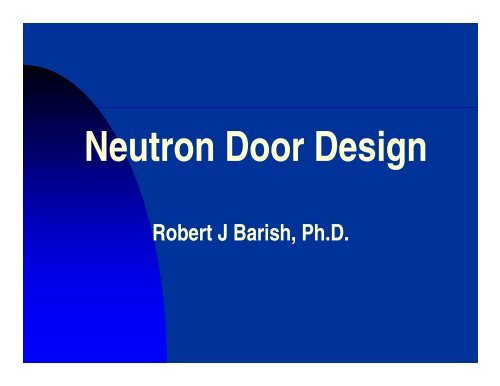Create successful ePaper yourself
Turn your PDF publications into a flip-book with our unique Google optimized e-Paper software.
<strong>Neutron</strong> <strong>Door</strong> <strong>Design</strong><br />
Robert J Barish, Ph.D.
Alternate form vendor information (Siemens)
Mazed Vault
d 1<br />
S 0<br />
d 2 S 1
Starting gp point for door calcs. (easy way)<br />
Varian 10 MV 0.00004 Sv/Gy (at 1 m)<br />
Example: 500 Gy x 0.00004 Sv/Gy = 20 mSv<br />
(50,000000 cGy x 0.0000400004 cSv/cGy = 2 cSv = 20 mSv)<br />
But consider 50% IMRT, with “IMRT factor” = 4<br />
250 Gy x 0.00004 Sv/Gy = 10 mSv<br />
250 Gy x 0.00004 Sv/Gy x 4 = 40 mSv<br />
Total: 50 mSv (at 1 m)
Kersey Method<br />
Varian 0.00004 Sv/Gy (at 1 m)<br />
A “typical” maze length is about 6 m. Its height is 3 m and width is 2 m<br />
A 6<br />
2<br />
S<br />
Area = 6 m 2 = S 1<br />
A typical gap between the maze and the far wall is 2.5 m and room<br />
height is also 3 m . Area=75m 7.5 2 =S<br />
0<br />
Kersey’s formula gives the neutron dose at the door as the neutron dose<br />
at the isocenter x (1/d 1 ) 2 x (S 0 / S 1 ) x 10 -(d 2/ 5)<br />
Using the previous value of 50 mSv and a<br />
“typical” d 1 value of 5.5 m, obtain the<br />
following: (1/5.5 (1/55 m) 2 x (7.5 m 2 /6 m 2 ) x 10 -(6 / 5)<br />
x 50 mSv = 0.13 mSv = 130 µSv at the door.
Starting point for door calcs. (hard way)<br />
<strong>Neutron</strong> fluence in NCRP 151<br />
Φ = βQn + 54βQ 5.4 βQn + 13Q 1.3 Qn<br />
4πd 2 2πS r 2πS r<br />
Β = transmission through head<br />
Qn = neutrons per Gy of x-rays<br />
S r = total surface area of room<br />
2π accounts for scattered and<br />
thermal neutrons entering maze
<strong>Neutron</strong> fluence in NCRP 151, Table B.9<br />
Φ A = βQn + 5.4 βQn + 1.3 Qn<br />
4πd 2 2πS r 2πS r<br />
Β =1 for Pb; d=5.5 m; S r = 250 m 2<br />
Q n = 6 x 10 10 neutrons/Gy<br />
Result:<br />
Φ A = 4.14 x 10 8 neutrons at maze
Modified Kersey Method<br />
Varian: neutron fluence (10 MV) = 6 x 10 10 /Gy<br />
Φ = 4.14 x 10 8 neutrons at maze<br />
H n,d = 2.4 x 10 -15 x 4.14 x 10 8 x (S 0 /S 1 ) 1/2 x [1.64 x 10 -(d 2/ 1.9 )<br />
+ 10 -(d 2/ TVD )<br />
]<br />
where TVD = 2.06 (S 1/2<br />
1 )<br />
Equivalent dose = H x W L<br />
Using the same values of d, S, and W as previous, we obtain a value of<br />
TVD = 5.05 m , H = 7.3 x 10 -8 Sv/Gy<br />
AndwithW L = 250 Gy conv + 1000 Gy IMRT , H n,d = 92 µSv<br />
Remember 0.004% for Varian production at 10 MV So one expects 0.4<br />
x 330 µSv = 130 µSv using the Kersey Method<br />
x 330 µSv = 130 µSv using the Kersey Method. Use modified for<br />
only for non-standard rooms and save lots of work.
Typically shield to equal contribution<br />
of neutron dose and photon dose at<br />
the entrance, 50 µSv each<br />
1 TVL = 4.5 cm borated poly for mazed rooms<br />
1 TVL = 8.5 cm borated poly for direct-shielded rooms.<br />
Material is available in sheets of 2.54 cm thickness in USA.<br />
Using the values just obtained: 130 µSv<br />
Need 2.54 cm BPE for mazed door<br />
Once the neutrons are dealt with, there is the photon dose from three<br />
sources to be handled:<br />
(1) Direct leakage<br />
(2) Capture gamma radiation<br />
(3) Room and patient scatter
Capture-gamma radiation (thermal n’s)<br />
Boron: 420 keV Polyethylene: 2.22 MeV<br />
BPE: 478 keV<br />
Typical intensity at the door for mazed rooms is 1/5 of the<br />
neutron dose at t (Kersey, March 1980).<br />
Note that he says mGy gammas = 1/5 mSv n’s<br />
But Kersey references ICRP 26 (1977), Q for neutrons was<br />
lower than at present: So there is an additional factor of 2 that<br />
is sometimes ignored. (Also ICRP 21, 60 and 103 complicate)<br />
mGy gammas really = 1/10 mSv n’s.<br />
TVL= 6 mm Pb for BPE gammas.
Going back to our example for the mazed room, we<br />
had 130 µSv at the door.<br />
0.1 x 130 µSv = 13 µGy from capture gammas.<br />
For high-energy h maze rooms neutron capture<br />
gammas are the dominant component and patient<br />
wall photon scatter can be ignored.<br />
NCRP 151 uses a formula for the capture gamma<br />
dose rate: h φ = K φ A 10 -(d 2 /TVD)<br />
where K= 6.9 x 10 -16 Sv m 2 per unit neutron<br />
fluence at point A, φ A was defined earlier, d 2 is<br />
maze length, and TVD = ~5.4 54 for x-rays 18-25 MV<br />
and ~3.9 m for 15 MV.
Let’s see how this complex approach compares with the simplistic one of<br />
assuming capture gamma dose is 1/10 of neutron dose. Let us use a 15<br />
MV accelerator as an example. First, the complex method:<br />
Φ A = βQn + 5.4 βQn + 1.3 Qn<br />
4πd 2 2πS r 2πS r<br />
Β =1 for Pb; d=5.5 m; S r = 250 m 2 Q n = 76 x 10 10 neutrons/Gy<br />
Φ A = 5.25 x 10 9 neutrons at maze entrance<br />
h φ = K φ A 10 -(d 2 /TVD)<br />
where K= 6.9 x 10 -16 Sv m 2 per unit neutron fluence at point A, φ A was<br />
defined earlier, d 2 is maze length, and TVD = ~5.4 for x-rays 18-25 MV and<br />
~3.9 m for 15 MV. (I’ll use 6 m maze as earlier.)<br />
h φ = K φ A 10 -(d 2 /TVD)<br />
= (6.9 x 10 -16 )(5.25 x 10 9 )10 -(6 /3.9) = 1.05 x 10 -7 Sv/Gy<br />
1.05 x 10 -7 x W L = 1.05 x 10 -7 x 1,250 Gy = 131 µSv = 131 µGy
Next, the simple method:<br />
At 15 MV, neutron production = 0.07% 0 of primary<br />
1,250 Gy x 0.0007 = 0.875 Sv = 875 mSv<br />
Using Kersey method, 875/(5.5 m) 2 x 7.5/6 = 36 mSv at<br />
maze entrance. 36 mSv x 10 -(6/5) = 227mSv(n’s) 2.27 atdoor<br />
2.27 mSv x 0.1 = 0.227 mGy = 227 µGy<br />
Compare this with the 131 µGy just calculated.<br />
Also note that the TVD in the “complex” formula is actually<br />
~ 39 3.9 m as opposed dt to “exactly” 39 3.9 m, and you can easily<br />
see that the results are quite comparable. Any difference is<br />
covered by the use of a TVL of 6.1 cm Pb for the photons.
In addition to the capture gamma<br />
component, there will also be direct<br />
leakage and room scatter to the door. For<br />
high-energy rooms, the room and patient<br />
scatter is low compared with the capture<br />
gamma radiation i and may be ignored.<br />
Typically, a maze wall is designed to allow<br />
50 – 100 µGy to impact the door from<br />
direct head leakage. Let’s assume a value<br />
of 100 µGy for the purpose of calculating<br />
the door.
So what would this door look like<br />
2.27 mSv of neutrons at the door must be reduced to 50 µSv.<br />
2,270 µSv/ 50 µSv = 45.4x reduction<br />
Log 45.4 4 = 1.65, so use 1.65 TVL = 7.5 cm (3”) BPE<br />
The photon component, 227 µGy from capture gammas plus<br />
100 µGy head leakage, must also be reduced to 50 µGy.<br />
327 µGy/50 µGy = 6.54 x reduction<br />
Log 6.54 = 0.82, so use 0.82 TVL = 5 cm of Pb.<br />
The door is usually laminated between two steel sheets, each 6<br />
mm thick, so the Pb can be reduced by 6 mm total but round to<br />
“standard” materials.<br />
For balance, put the 2.5 cm (1”) on each side of the BPE.
Direct-Shielded Vault
d 1
Direct-Shielded <strong>Door</strong> d 2 = 0<br />
Varian: neutron fluence (10 MV) = 6 x 10 10 /Gy<br />
Φ A = βQn = 1.92 x 10 8 (d= 5 m to door)<br />
4πd 2<br />
H n,d = 2.4 x 10 -15 x 1.92 x 10 8 x 1 x [1.64 x 1 + 1]<br />
Equivalent dose = H x W L<br />
H = 1.22 x 10 -6<br />
Sv/Gy<br />
And with W L = 250 Gy conv + 1,000 Gy IMRT , H n,d = 1,520 µSv<br />
Using Kersey: 50 mSv x (1/5 m) 2 = 2000µSv 2,000 Again, using Kersey saves lots of time. NCRP 151<br />
says it is “conservatively safe” to take this approach.
Photons At <strong>Door</strong><br />
Leakage radiation is dominant component.<br />
Capture gammas, room and patient scatter<br />
are also to be considered.<br />
1) Direct leakage<br />
Simple inverse square to door position<br />
2) Capture gammas<br />
h φ = K φ 10 -(d 2 /TVD) A where d 2 = 0 (So, simply py K φ A )<br />
3) Room and patient scatter<br />
Since scattering angle is ~ 90°, energy is < 0.3 MeV, so it can be ignored.
Example calculation: d = 6 m W L = 1,250 Gy x 0.001<br />
001<br />
Direct Leakage<br />
1,250 Gy x 0.001 x 1/6 2 = 3.47 cGy = 34,722 µGy<br />
Capture gammas<br />
K φ A = 6.9 x 10 -16 Sv m 2 x 1.92 x 10 8 = 1.32 x 10 -7<br />
1.32 x 10 -7 x 1,250 Gy = 165 µGy<br />
Total = 34,887 µGy
So what would this door look like<br />
1,390 µSv of neutrons at the door (50 mSv x 1/6 2 ) must be<br />
reduced to 50 µSv.<br />
1,390 µSv/ 50 µSv = 27.8x reduction<br />
Log 27.8 = 1.44, so use 1.44 TVL = 12.3 cm (5”) BPE<br />
The photon component , 34,887 µGy, must also be reduced<br />
to 50 µGy.<br />
34,887 µGy/50 µGy = 697x reduction<br />
Log 697 = 2.84, so use 2.84 TVL = 17.3 cm of Pb.<br />
The door is usually laminated between two steel sheets,<br />
each 6 mm thick, and the 12.3 cm of BPE = 0.32 TVL (20<br />
mm Pb equiv), so the Pb can be reduced by 26 mm total.<br />
For balance, put the 7.5 cm (3”) on each side of the BPE.
Sliding <strong>Door</strong> problem
To isocenter<br />
Sliding <strong>Door</strong> problem
















